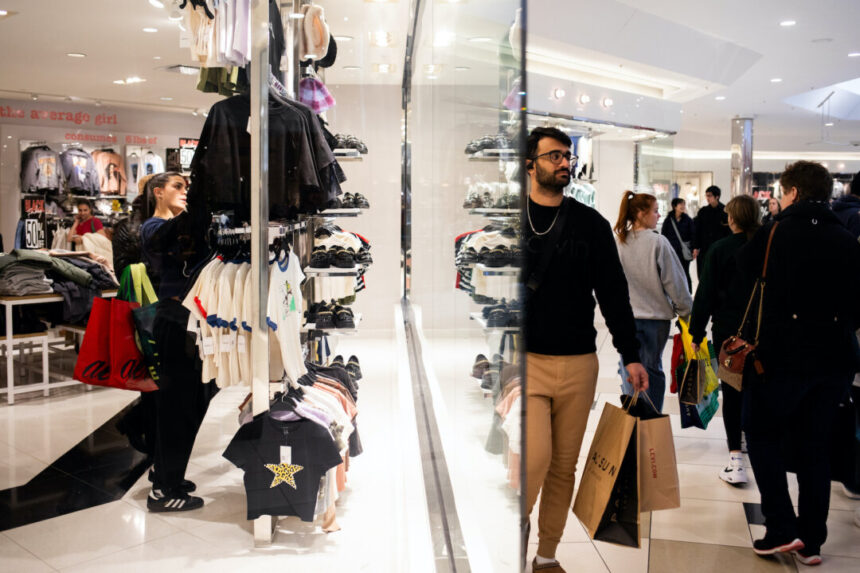Consumers are combating sticky and stubborn inflation by trading down for cheaper goods and services across various categories, including groceries, according to new data by Adobe Analytics.
Trading down—adjusting the type or quantity of purchases for lower pricing and better value—has become more common in recent years.
Studies, from CNBC to Bankrate, show that most Americans live paycheck to paycheck, and many households have exhausted their pandemic-era savings. As a result, shoppers are now trying to stretch their dollars. One way to achieve this has been to shift their spending patterns to cheaper goods.
Adobe reviewed comprehensive online shopping data from January 1 to April 3. The analysis highlighted that low-priced items accounted for a substantial share of online unit sales compared to five years ago.
Personal care, for example, saw the share of unit sales originating from the cheapest quartile of goods surge 96 percent from January 2019 to April 2024.
This was also observed in electronics (64 percent), apparel (47 percent), furniture and bedding (42 percent), and home and garden (42 percent).
Consumers also concentrated their money on the cheapest products sold at supermarkets, with the share of unit sales coming from the least expensive quarter of products rising 33 percent in the first four months of 2024.
“Within a category like groceries, the data showed that goods with low inflation saw revenue grow by 13.4%, while products with high inflation saw revenue drop by 15.6%,” Adobe said in the report.
The Adobe study also noted other consumer trends so far this year. Consumer spending climbed 7 percent year-over-year to $331.6 billion. Buy now pay later (BNPL) growth surged 11.8 percent year-over-year. E-commerce prices tumbled 5.6 percent year-over-year in April.
“Strong consumer spending this year has been driven by net-new demand, as opposed to higher prices,” the Adobe research noted.
Other studies have spotlighted comparable consumer trends.
A first-quarter McKinsey report found that 76 percent of consumers reported participating in trade-down actions. This was little changed compared to the fourth quarter of 2023.
In January, PYMNTS Intelligence published a report titled “Consumers Shop Secondhand Stores as Often as Other Retail.” The findings revealed that consumers have been increasingly shifting to lower-cost retail locations.
Corporate America: Inflation Weighing on Wallets
Price inflation continues to impact businesses and consumers. Since 2021, the consumer price index (CPI) has rocketed at a cumulative pace of 19 percent, and Americans’ purchasing power has declined more than 16 percent.
The reacceleration in inflation has weakened consumer sentiment. From the University of Michigan’s Consumer Sentiment Index to The Conference Board’s Consumer Confidence Index, the public’s attitude toward the economy has reversed amid the lack of progress in the inflation fight.

In addition, the research indicated that households are becoming more skeptical about the labor market and broader economic conditions.
Companies have noticed that consumers, particularly low-income patrons, are frequenting their locations less. This has forced them to issue less-than-stellar forecasts for the coming quarters.
In their latest quarterly earnings reports, some of the biggest brands reported that price pressures have created a more cautious and price-sensitive customer.
McDonald’s, for example, stated that the fast-food industry is engaged in a “street-fighting mentality” as consumers wrestle with “elevated prices in their day-to-day spending.”
“Clearly, everybody’s fighting for fewer consumers or consumers that are certainly visiting less frequently, and we’ve got to make sure we’ve got that street-fighting mentality to win, irregardless [sic] of the context around us,” McDonald’s CFO Ian Borden said in company’s April 30 conference call.
Melanie Boulden, the chief growth officer at Tyson Foods, explained that “the consumer is under pressure”—particularly the “lower-income households.”
On a May 1 earnings call, Kraft Heinz CEO Carlos Abrams-Rivera asserted that there is a “gap” between high- and low-income consumers, and the divergence “shows a clear and continued bifurcation.”
“The lower-income consumers are challenged with interest rates remaining high, gas prices elevated, and savings dwindling,” Mr. Abrams-Rivera stated. “So, there’s a clear pullback of restaurant spend by these lower-earning households, especially in restaurants and convenience stores. These consumers instead are looking for value as they prepare more meals at home.”
What Main Street Expects
Penny-pinching consumers might not see any price relief on the way as businesses continue raising their prices in response to their own growing input costs.
New data from RedBalloon’s March Freedom Economy Index suggests that three out of four businesses reported supplier price hikes in the last 30 days, and 84 percent of small business owners anticipate inflation to be higher for longer in the next six months.
Consumers are already bracing for this climate.
The Federal Reserve Bank of New York’s Survey of Consumer Expectations (SCE) showed that one-year inflation expectations rose for the first time in four months to 3.3 percent in April. The SCE figures showed that year-ahead commodity price predictions rose for a wide array of goods and services, such as college education, medical care, housing, food, and gasoline.
Median household income growth expectations slipped to 3 percent, and median household spending grew to 5.2 percent.
Please rewrite the following sentence:
“The cat was asleep on the windowsill.”
Source link








